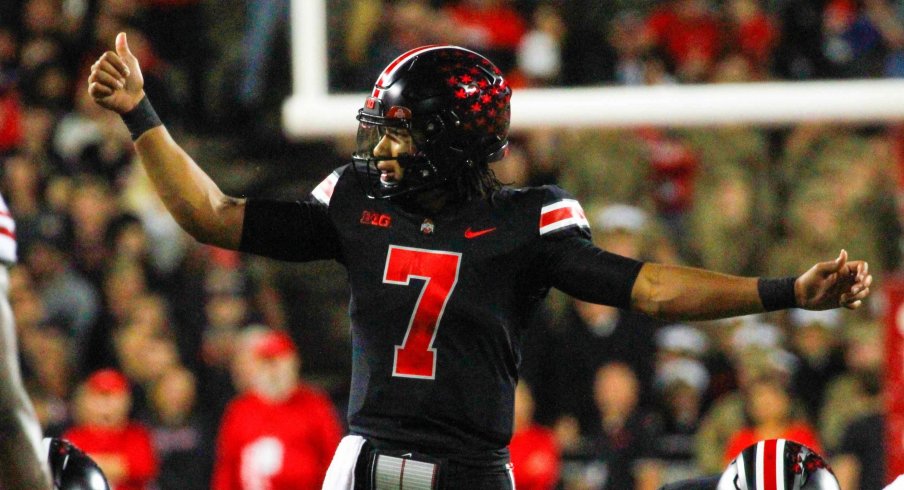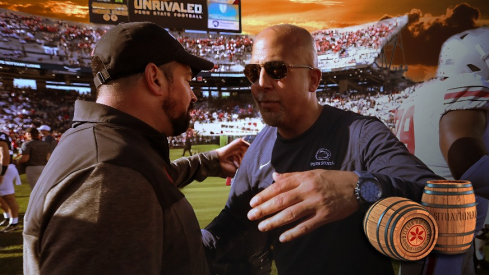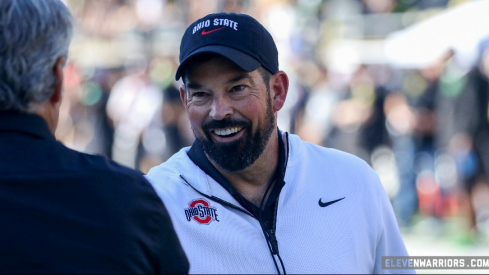On most draft boards, he's already QB1.
Through four games of his second, and almost certainly, final, season under center for Ohio State, C.J. Stroud has lived up to all the expectations. With his team sitting at 4-0 and looking every bit the national title contender, the redshirt sophomore is currently the betting favorite to win the Heisman.
He is tied for the national lead in touchdown passes with 16 and second in QB rating. He's 12th in passing yards despite having attempted just nine passes in fourth quarters this season, often watching from the sideline with his team up big during the final period.
After dispatching two of the nation's best defenses a year ago in Notre Dame and Wisconsin, and doing so without the help of his top three targets from a year ago, Stroud has seemed to cement his place atop another leaderboard:
My early-season quarterback rankings for the 2023 draft. My comp for Will Levis is Matthew Stafford. https://t.co/i5EnkqSFF4 pic.twitter.com/rQ4qSOpvzG
— Mel Kiper Jr. (@MelKiperESPN) September 28, 2022
Those who watched him lead an offensive attack last Saturday night that scored on its first five possessions surely came away impressed, as the Buckeyes effectively ended the game before halftime. It hardly seemed to bother Stroud that Jaxon Smith-Njigba was standing on the sideline in street clothes yet again, as he found open receiver after open receiver, anticipating open windows and dropping in one pass after another while making yet another well-respected defense look pedestrian.
The Californian is perhaps the best conductor yet of what has become the sport's most beautiful orchestra, incorporating a talented cast of individual performers into one cohesive unit, capable of playing both in perfect unison or as dynamic soloists. But the most important element in both this metaphor and the real-life Buckeye offense is the vision of the composer.
Ryan Day, of course, is the Buckeye Beethoven in this analogy, and his ability to game plan has not only allowed Stroud to thrive while wearing the Scarlet and Gray, but his predecessors as well. This ability to make it look so darn easy for guys like Dwayne Haskins and Justin Fields has actually made NFL scouts begin to question how well it prepared them for the next level.
For instance, NFL Network's Daniel Jeremiah wrote the following as part of his preseason evaluation of Stroud in July:
Ohio State quarterback prospects are very difficult to evaluate. The offensive scheme is effective, the line play is solid and the wideouts are spectacular. Those circumstances don't provide a ton of tight-window opportunities for the passer. I know the NFL track record of Buckeye quarterbacks hasn't been stellar, but I believe you need to evaluate every player on an individual basis.
Surely, some who just read that statement will get defensive and find a reason to diminish Jeremiah's record as an evaluator. But, he does make a legitimate point.
The Buckeye offense is so well run that those talented wideouts are often wide open, and Stroud rarely has to deal with pressure thanks both to the play of his massive offensive line, and the call from the sideline. Day and his staff instantly recognize an opponent's scheme and adjust as needed, having done their homework in both the offseason and during the week prior.
"It's the players and the coaches who put the plan in, teach it, walk through it, just to get one play ready," Day said this week of the amount of preparation required for a single play-call. "We missed a play that we had an opportunity [against Wisconsin]. It drew up exactly the way we wanted it to, but the protection broke down and we didn't hit it, and it was like a knife right in your chest. Hours and hours and hours of time for that one play, and we didn't quite get it. But there was a lot in that game that we did get."
When Wisconsin switched from a single-high safety look on early downs to a two-deep look, hoping to slow the OSU passing game in any manner, Day and co. changed the play from the sideline to an easy RPO. Before the ball was even snapped, Stroud knew where to go with the ball and easily put it on his wideout for what became a quick first down.
This change at the line of scrimmage has become common for the Buckeyes under Day, with the offense rushing to the line in order to get the defense to show its hand, only to pause and look to the sideline for a play-call meant to exploit it. But just when defenses start to catch on to this pattern, Day and his staff pounce.
On the very next snap, the Buckeyes rushed to the line with only the tight end, slot receiver, and running back adjusting their alignment, allowing the outside receivers and offensive line to get set quickly. The Badgers were still looking for their own coaches to call a play when Stroud snapped the ball and fired a ball wide to Marvin Harrison Jr., who was wide open near the opposite sideline.
While the schemes themselves can be found in most NFL playbooks, it is the way they are packaged together and the talent executing them which makes those at the next level question the translation of Ohio State's offense to their game. NFL quarterbacks simply don't get to throw to receivers that are so wide open, so often.
But it's not as if the Buckeyes run a gimmicky offense, or the way Stroud has been trained to process information has no application to Sunday football. While his coaches do an outstanding job of preparing for an opponent and getting the offense into the right play-call, Stroud also knows how to find an open receiver based on the look being shown by the defense.
Young quarterbacks that come from systems that create open receivers so easily have struggled to adjust to the next level, and that label will assuredly be placed on Stroud.
While NFL play-callers can speak directly into a speaker in their quarterback's helmet, no one wants to rely on that communication to help dissect defenses, the way Sean McVay famously did with Jared Goff during their time together with the Rams. It wasn't until McVay had a QB who could identify what the defense was doing on his own in Matthew Stafford that the Rams got over the hump and finally won a Lombardi Trophy.
But although Day gives his quarterback plenty of help to identify what the defense is doing, it's up to Stroud to both see it from the pocket and to deliver the ball accurately.
It certainly helps to have receivers like Harrison who win almost every one-on-one battle with their opponent, but Stroud saw what the defense was giving him and made the right decision in this example. This was not an Air Raid quarterback running Mesh for the 20th time in a game or an option QB reading an out-of-control end, this was a good play-call that was executed perfectly.
Stroud's predecessor, Fields, may suggest that he stay in Columbus as long as possible, given the experience he's had thus far in Chicago. While there are countless issues with the Bears' offense right now, the knock on Fields is that he is hesitant to throw into tight windows, something he rarely had to do at OSU.
For his part, Stroud has shown less hesitance in those situations.
As any good defense does, the Wisconsin staff made some adjustments at halftime, despite the score already being lopsided. While the Buckeyes continued to move the ball downfield, the Badgers began mixing up their looks even more in hopes of confusing Stroud after the ball was snapped.
Faced with a 3rd & 5 in the red zone, Wisconsin DC Jim Leonhard called a simulated pressure that sent a blitz through the interior of the offensive line, but still dropped seven defenders into zone coverage. Expecting the Buckeyes to pass, the call was a good one, as Stroud wouldn't have the threat of a downfield receiver stretching the secondary vertically, thanks to the back line of the end zone.
But despite the Badgers blanketing three receivers with four defenders on the right side, Stroud threw a dart to Julian Fleming right between two Badgers, allowing the wideout to make a play after the catch and find the end zone.
The pass concept, known as 7-ins, is not the first choice against three-deep zones and is often deployed against two-deep or man coverages. Yet Stroud recognized the change in coverage after the ball was already in his hands and still worked through his progression in time to fire a strike. Fleming may have scored thanks to a big, pass-rushing edge defender being asked to tackle him in space, but the throw from Stroud would have moved the chains even if his receiver had gone down immediately after hauling in the catch.
Ultimately, many of the throws in Stroud's highlight reel might be fun for Buckeye fans to watch, with receivers embarrassing an opposing corner or running wide open across the middle of the field with nothing but green grass (or field turf) in front of them. But it's passes like the one to Fleming that will ultimately keep him in contention for the #1 overall pick in the spring.



